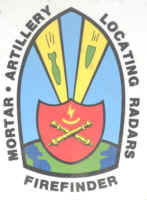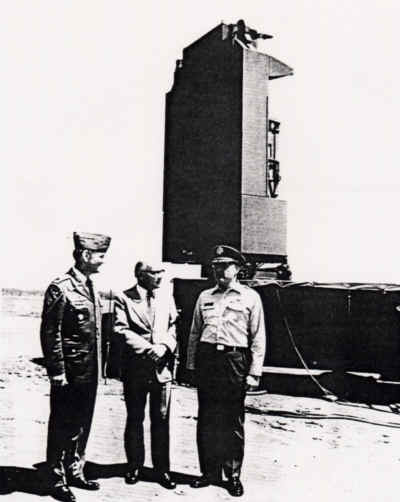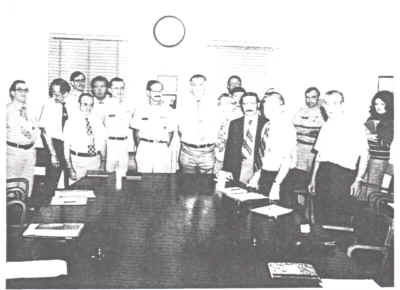The History of InfoAge Science & History Museums
A Silver Anniversary Fire Finder History A Silver Anniversary Fire Finder History
A Silver Anniversary Fire Finder History
Web editor note: This project, developed for a possible Soviet block invasion of Europe, was very important in the Iraq / Desert Storm battles. The last surviving WWII ‘Special Antenna Shelter’, Building 9017 was modified to accommodate work on these specialty radar counter-fire systems.
Eyes for the King of Battle
The concept of using a radar system as a battlefield instrument for locating enemy mortar and/or artillery originated in the United States at Fort Monmouth, New Jersey in the 1944. The objective of the initial program was to develop and field a radar system capable of meeting the Army’s requirements for detecting and locating hostile weapons with sufficient speed and accuracy to permit rapid and effective engagement by friendly counterfire. It wasn’t until 1951 that such a system, the AN/MPQ-10 was developed and built by Sperry Gyroscope (now Lockheed Martin) for use in the KOREAN war. However, its operational capability was determined to be inadequate for meeting long-term Army requirements. The MPQ-10 was replaced in 1958 by the AN/MPQ-4. The MPQ-4 built by General Electric (now Lockheed/Martin), was a dual beam rapid scan radar using vacuum tube technology, an analog computer, mechanical scanning, and unsophisticated extrapolation techniques. The AN-MPQ-4 operated successfully, as a mortar locating radar; but, its ultimate performance was limited by its need for constant operator alertness, limited multiple target handling capability, and its significantly degraded performance in rain. The MPQ-4 was used in a limited capacity against hostile artillery in VIETNAM. The AN/TPQ-5 Artillery Locating Radar was developed along with the MPQ-4 by General Electric. It used similar scanning techniques and also included a monopulse tracker. It met its basic technical requirements; but, changing user requirements caused cancellation of the program. In 1962, another attempt at development of an artillery locating radar resulted in the AN/MPQ-32 built by Sylvania. This was a mechanical scan radar whose ultimate performance was never achieved, primarily due to limitations in the state-of-the-art at that time.
In response to the need for a rapid point defense capability during the VIETNAM Conflict, in 1967, the Army established a high priority program for the development of the AN/TPQ-28 360 degree (omni-directional) Mortar Locating Radar This radar was built by ITT/GILFILLIAN to provide automatic computer controlled capabilities. Unforeseen complications in the automatic processing of multiple targets and clutter resulted in an unacceptably high false alarm rate, and the TPQ-28 was not deployed as intended. Subsequently, the problems were corrected and the equipment successfully demonstrated the feasibility of a fully automatic weapons locating radar. It was used later as a range tracking radar. A Mortar and Artillery Locating Radars (MALOR) Project Office was established in June 1972. Study efforts were initiated to define realistic and attainable performance characteristics. From these studies, came the design and performance characteristics basis for the AN/TPQ-37 Artillery Locating Radar. Concurrently with these studies, the TPQ-28 was used to demonstrate the probability of location accuracy, detection range, and the technical features upon which the AN/TPQ-36 performance requirements were based. Approval of the AN/TPQ-36 Mortar Locating Radar Program had been authorized by the Department of the Army in January 1971. Following an industry wide competition in 1972, the Ground Systems Group of Hughes Aircraft Company was selected as the developer of the TPQ-36. In June 1972 competitive advanced development prototype contracts for an Artillery Locating Radar were awarded to the Sperry Gyroscope Division of Sperry Rand and to the Ground Systems Group of Hughes Aircraft Company. Advanced Development Models of the AN/TPQ-37 Artillery Locating Radar built by each contractor were competitively field tested in 1975. After the competitive “shoot off”, Hughes Aircraft Company was selected to produce the TPQ-37.
The organizational event that best symbolized the successful development of the TPQ-36 and TPQ-37 radars was the selection by the Army of the popular name FIREFINDER to replace the project name MALOR. In announcing the name change, the Department of the Army press release said the FIREFINDER system “has demonstrated the capabilities to provide a major breakthrough in the age-old problem of locating enemy mortars and artillery”, and the new name “emphasizes the Army’s firm commitment to place in the field a major new capability which is high on its priority list of material requirements.”
The AN/TPQ-37 Initial Operational Capability (IOC) was achieved on 18 December 1980 when two of the AN/TPQ-37 radars were deployed to the Is` Cavalry Division, at Fort Hood, Texas. Typically two AN/TPQ-37s are deployed per Target Acquisition Battery (TAB) per Division Artillery or 2 per Field Artillery Detachment at Corps Artillery level. Since the first AN/TPQ-37 production was finalized in November of 1976, well over a 100 systems have been delivered for use by the U.S. Army and the Foreign Military Customers. The radar system was deployed to US Forces abroad during the cold war era to the peace keeping forces. First oconus deployment was to V and VII Corps in USAREUR in 1981 at various bases in then West Germany. Later that year radars were deployed to the 2″d ID along the Korean DMZ. Peace keeping deployments continue to present. The TPQ-37 saw live fire action in Somalia in 1988 in support of the US Marine Corps. In 1991 during Desert Storm, 21 TPQ-37s were deployed to the Middle East in support of VII & XVIII Corps. The success of the TPQ-37 was summed up in a quote from an Iraqi POW as told to a U.S. Army Weapon Locating Officer, “We couldn’t fire our artillery; if we did, the steel rain (MLRS M-77 Bomblets) would come… all we could do was surrender”. Every enemy shell had a target attached to it. Iraqi’s supposed artillery advantage of more guns, with longer reach was turned into a myth thanks to FIREFINDER. One single TPQ37 assigned to the US Marines recorded 52 hostile artillery kills in the march from the border to Kuwait City.
Over the years the TPQ-37 has undergone many phased improvements to improve its capabilities. Starting in the early 80s and progressing to the current time-frame, improvements included the addition of Kevlar to the Antenna Transceiver Group doubling the computer memory to accommodate numerous software upgrades, mounting on the M1048 trailer, addition of a tracked suspension system to the trailer for greater mobility, addition of a self survey capability, addition of Long Range Software (SCUD finding), reliability improvements, the capability to be loaded on a C-130/141 without the use of heavy equipment, and the remounting of the Operations Control Shelter on a HMMWV. The most ambitious of all improvements to the TPQ-37 has now started in the form of the Firefinder Block II Pre-Planned Product Improvement. In FY 98, an Engineering Manufacturing Development (EMD) effort will thrust the TPQ-37’s capability and technology well into the 21s` century with improvements that will increase its hostile track volume by over 800%, more than double the effective range and increase the system transportability and mobility. In addition the system will capitalize on the TPQ-36 upgrade program for digital and data processing capabilities.
The AN/TPQ-36 Mortar Locating Radar contract awarded in 1972 was for 5 EMD radars. The radar design drew heavily on lessons learned from the earlier TPQ-28 program. This allowed skipping an Advanced Development Program. Test of the first unit at Yuma Proving Ground in late summer 1975. In the period of 1975 to 1977 extensive qualification testing of the design occurred, including DT and OT tests at Aberdeen Proving Grounds, 29 Palms Marine Base, California and Ft. Carson, Colorado. In 1979 and 1980 the TPQ-36 was modified to accommodate US Marine Corps requirements for 360° search (extended azimuth search), hostile impact predict and artillery location. After 1980 the TPQ-36 was referred to as a “Weapon Location Radar”. During the Spring/Summer of 1979, the TPQ-36 was live fire comparison tested with the US Marine Corps Hostile Weapon Locating System (HWLS) radar at Yuma Proving Ground, Arizona. This testing was followed by live fire testing in the rain at Fort Stewart, Georgia. As a result of this “shoot off’ the US Marine Corps canceled the HWLS program and fully committed to the Army’s FIREFINDER Program. In 1978 a Common Shelter Program had been initiated for the FIREFINDER family of radars. This gained production quantity cost advantages and logistics commonality for the FIREFINDER system. The TPQ-36 EDM Program was so successful that in 1979 two radars were sent to Europe for early operational field experience. In 1978 a multi-year production contract was awarded for 199 radars for the US Army, US Marine Corps and the Royal Netherlands Army and other FMS countries.
The TPQ-36 first saw combat in Lebanon in 1983. Radars were operated by US Army personnel, deployed with the US Marine to protect the Beirut Airport. In Lebanon the TPQ-36 demonstrated that it was tough enough to sustain battle damage and keep on operating. It was also in Lebanon that the US Army suffered the first causalities of FIREFINDER operators. The TPQ-36 has seen action in Granada, Panama, Somalia Thailand (with the Thai Army) and in Desert Storm. Today, TPQ-36 radars from six nations are deployed in Bosnia. There have been nearly 250 TPQ-36 radars manufactured and deployed in 17 countries. The TPQ-36 has reputation as a “soldier’s” radar. In the mid-1980’s an air defense variant of the TPQ-36 radar was developed. to become the basis for the Norwegian Adapted HAWK and NASAMS (ground launched AMRAAM) air defense programs and, ultimately, for the AN/MPQ-64 (Sentinel) radar. When the total quantities of TPQ-36 and all of its variants are added together, there will be over 400 radars built and deployed by the year 2000. This quantity will put the TPQ-36 radar in unique class rivaling the fabled SCR-584 as one of the most widely deployed radars ever built.
The success of the FIREFINDER Program is a tribute to those in the Fort Monmouth Community who have led the world in development and fielding of Radar Systems for Defense of Freedom. The History of Radar at Ft. Monmouth is ” The History of Radar”. Starting with. the development and ultimate manufacture of the SCR-268 at the Signal Corps Laboratory at Camp Evans in 1939, the Radar laboratories have been at the forefront of innovation and development of Radars for Air Defense, Combat Surveillance and Weapons Location. The building currently housing the PM FIREFINDER Office are the same buildings used by the builder of the first radar for the U.S. Army. As we celebrate the 25`h Anniversary of the FIREFINDER Program, we are also witness to the closing of Camp Evans. In August 1997 PM Firefinder, fittingly the last Resident of “Building One”, will move the “Flag” and start a new tradition of Radar Excellence at a new home on Ft. Monmouth proper.

Photo Of The First Malor / Firefinder Leadership Team
The Malor Project Manager Col William J. Harrison With Mr. Clare Carlson Of The Ground Systems Group Of Hughes Aircraft Company And Mg David J. Ott Cg Field Artillery Center At Fort Sill, Oklahoma With The Original An/Tpq-37 Artillery Locating Radar Advanced Development Model.

Photo Of The Original Malor Project Office Team July 1973
L To R, John Swannick, Hal Katz, Cpt Bob Doheny, Bob Mitchell, Frank Murphy, Maj Jay Hern, Cpt Glen Goss, Jerry Kurman, Mack Williams, Hank Greenberg, Andy D’angelo, Cpt Jim Vandernaald, Ray Russomanno And Mary Schlauch
There are no upcoming events at this time
We Need Your Help! Volunteer with Us.
Join our mission to preserve historic Camp Evans and teach the public about science and history.
Sign up to join our team of volunteers and start on your own mission today.
InfoAge Science & History Museums
2201 Marconi Road
Wall, NJ 07719
Tel: 732-280-3000
info@infoage.org
webmaster@infoage.org